|
|
misteri kewujudan makhluk aneh dan misteri di zaman purbakala
[Copy link]
|
|
|

Banshee
Banshees are believed by some to be spirts of nature or pre-Christian Gaelic deities. In Theosophy and in Celtic Christian religion, they are commonly called "fallen angels". In English, they are described as a "fairy" or "fairy woman".
The Banshee is also said to be tasked with the job of warning selected members of ancient Irish families of the time of their death. According to tradition, the banshee was only said to cry for four major families but this list seems to have been extended due to marriage.
Apparently in terms of clothing, she either wears a grey, hooded cloak or a grave robe meant for the unshriven dead. Those who where not allowed to find "absolution".
Banshee usually come in three of many forms, the first being a young woman, the second being a rich middle-aged lady or matron, and the third being of a fraglie old woman. Another being, the bean-nighe (washing woman). In this form, she is apparently seen washing the bloodstains out of the fated person clothes.
Rarely seen but heard, her mourning call is often given at night when someone is about to die. In 1437, Scottish King James the I is said to have been approached by one such being. There have been numerous reports of same thing happening to members of the royal court and other high-profile members of Irish society.
The quality of her voice varies to region to region. Some describe it as 'low and pleasant' which can be used to comfort people or generally just to make them feel good and others as 'a mix of a wail of a woman and a moan of an owl' which can hypnotize many. Some also take to singing songs to do the work, and put power into it without changing the sound.
When several banshees appear at once, it is said that a person great or holy has died. Banshee are commonly decipted as having long, fair hair which they comb with a silver comb. If one is to see such a comb, it is suggested not to pick it up or that person might be spirited away. Though to some the comb is simply a gift to someone they love or feel is important.
Banshee are fairly popular and enjoy the same status (in Ireland) as leprechauns. One possible origins of the Banshee are keeners. Woman in Ireland that sing songs of lament at funerals. The majority of these women quite possibly could be banshees that feel the need to sing in an attempt to raise or lower the feelings of those attending.
Banshees also apear in places where there is great sorrow and pain. |
Rate
-
1
View Rating Log
-
|
|
|
|
|
|
|
|
|
|
|
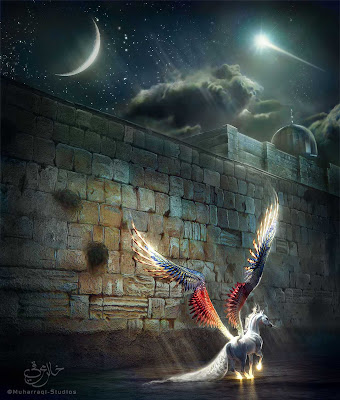
Buraq
Buraq atau juga disebut eja Al-Buraq (bahasa Arab: البراق , dari segi bahasa bererti "kilat cahaya". Ia adalah sejenis makhluk menyerupai haiwan, besar sedikit dari himar (keldai) dan kecil sedikit dari baghal (haiwan kacukan keldai dan kuda).Diriwayatkan juga buraq ini merupakan makhluk yang menyerupai haiwan lagenda iaitu seekor kuda putih yang bersayap burung berbulu pelepah yang besar.Namun ada juga yang mengatakan buraq menyerupai burung putih yang besar. Walaubagaimanapun ia dijadikan oleh Allah bukan dari jenis yang berdarah, berdaging dan bertulang belulang seperti haiwan, sebaliknya ia diciptakan daripada cahaya.
Buraq merupakan makhluk tunggangan Nabi Muhammad SAW dari Makkah ke Baitul Maqdis dalam peristiwa Israk Mikraj
Hikmah dijadikan buraq yang berfungsi sebagai kenderaan dan pesawat angkasa menyerupai seekor binatang walaupun unsur kejadiannya daripada cahaya, adalah bagi memudahkan Nabi Muhammad s.a.w. memahami tujuan Jibril datang membawa makhluk menyerupai haiwan untuk dikenderai oleh Nabi s.a.w. dalam peristiwa Isra dan Mi'raj. Kerana kenderaan yang lazim digunakan oleh manusia pada ketika itu ialah haiwan sama ada unta atau kuda dan seumpamanya.
Buraq mempunyai kelajuan yang luar biasa iaitu selangkah kakinya memacu, bergerak sejauh mata memandang. Sesuai dengan hakikat 'zat' lembaga buraq yang dijadikan oleh Allah SWT dari cahaya.
Ahli sains juga mendapati bahawa pergerakan yang paling pantas di alam maya ini ialah cahaya. Dalam kelajuan seperti cahaya, membolehkan Nabi s.a.w. tiba di Masjid al-Aqsa Baitul Muqaddis dalam waktu yang singkat. |
Rate
-
1
View Rating Log
-
|
|
|
|
|
|
|
|
|
|
|
Dalil
Didalam sepotong hadis yang diriwayatkan oleh Imam Bukhari dan Imam Muslim ada disebutkan,”...kemudian aku diberikan seekor binatang yang bukan bangal (peranakan kuda dengan keldai) namun melebihi keldai putih.” Al Jaruud mengatakan kepadanya,”Itu adalah Buraq wahai Abu Hamzah.” Anas mengatakan,”Betul. Dia (binatang) itu meletakkan langkahnya sejauh pandangan mata...”
Selain itu terdapat juga hadis yang diriwayatkan oleh Imam Bukhari seperti berikut:
“ Aku telah dibawa oleh seekor Buraq,seekor haiwan berkulit putih dan panjang,lebih besar daripada keldai tapi kecil sedikit daripada baghal. Setiap langkahnya bersamaan dengan sejauh mata memandang.(Riwayat Shahih Bukhari) ”
Al Hafizh Ibnu Hajar mengatakan bahwa “bukan bangal dan melebihi keledai putih” demikianlah disebutkan berikutan ia adalah binatang tunggangan atau dengan melihat lafaz “buraq”. Hikmah pensifatan itu adalah sebagai isyarat bahawa orang yang menungganginya adalah dalam keadaan aman bukan dalam keadaan perang atau ketakutan. Atau pula untuk menampakkan mukjizat yang terjadi kerana kecepatannya yang sangat cepat dengan menunggangi seekor binatang yang tidak pernah disifatkan dengan sifat seperti itu jika menurut keadaan normal. (Fathul Bari ...
Didalam hadis yang diriwayatkan oleh Tirmidzi dari Hudzaifah bin al Yaman mengatakan bahawa Rasulullah S.A.W telah diberikan seekor binatang yang punggungnya panjang dan langkahnya adalah sepanjang mata memandang. Mereka berdua (Rasulullah S.A.W dan Malaikat Jibril a.s.) tidaklah terpisahkan diatas punggung buraq sehingga mereka menyaksikan syurga dan neraka ... kemudian mereka berdua kembali pulang ke tempat semula (ketika berangkat)...” (Abu Isa mengatakan bahawa ini adalah hadis hasan shahih)
Imam Nawawi menyebutkan bahawa para ahli bahasa mengatakan, ”Buraq adalah nama binatang yang ditunggangi Rasulullah S.A.W di malam Israk.” Az Zubaidiy didalam “al Mukhtashar al ‘Ain” dan pemilik kitab “at Tahrir” mengatakan, ”Buraq adalah binatang yang ditunggangi oleh para Nabi a.s.”
Ibnu Duraid mengatakan bahawa “buraq” berasal dari kata al barqi beerti kilat, berikutan sifatnya yang sangat cepat. Ada yang mengatakan, ”Dinamakan buraq dikerana ianya terlalu bersih, mengkilat dan sangat cepat.” Ada yang mengatakan, ”Kerana warna putihnya.” Al Qodhi mengatakan, ”Kemungkinan dinamakan buraq kerana ia memiliki dua warna, dikatakan ‘syaatun barqoo’ (kambing kilat) apabila disela-sela bulunya yang berwarna putih terdapat bercak-bercak hitam” Dia berkata, ”(apa yang terkandung) didalam hadis itu disifatkan bahawa buraq itu berwarna putih. Boleh jadi ia dari jenis kambing kilat dan ia terbatasi dengan warna putih.” (Shahih Muslim bi Syarhin Nawawi al israa bi rosulillah...)
Terdapat juga hadis lain yang diriwayatkan oleh Imam Bukhari seperti berikut:
“
Kemudian dia (Jibrail a.s.) membawa Buraq yang memiliki wajah rupawan dan bertali kekang, bertubuh tinggi, berkulit putih, lebih besar dari keledai tetapi lebih kecil daripada baghal. Dia dapat menjejakkan kakinya sejauh pandangannya. Dia memiliki telinga yang panjang. Setiap kali dia melewati gunung, kaki belakangnya bisa memperpanjang langkahnya dan ketika ia menuruni bukit kaki depannya akan memperpanjang jangkauan. Dia memiliki dua sayap pada kedua pahanya yang dapat memberikan kekuatan untuk kedua kakinya.(Riwayat Shahih Bukhari)
”
Impak kebudayaan
Tembok Barat di Baitulmuqaddis dipanggil sebagai Tembok Buraq di mana baginda menambat Buraq di situ.
Dua syarikat penerbangan dipanggil sempena Buraq iaitu syarikat penerbangan Libya, Buraq Air dan syarikat penerbangan Indonesia, Bouraq Indonesia Airlines. |
Rate
-
1
View Rating Log
-
|
|
|
|
|
|
|
|
|
|
|

Chimera
The Chimera was a monstrous beast which ravaged the countryside of Lycia in Anatolia that was to be able to breath fire. There have been many discriptions of how it looks but in all the descriptions is it's half lion, goat & serpent,
The Chimera had the head/body of a lion, a goat head & a tail, tipped with a serpent's head
Next to the dragon, the chimera is the second most popular beast to guard portals.
The chimera is also female and is the youngest daughter of Echidna and Typhon. She is also said to be the last child the two had together.
The word chimera is also used in modern pop-culture within both the fantasy and science-fiction communities to refer to unnatural beings created from the combination of two or more animals by means other than breeding.
The Chimera may have once been identified with the winter-rising Constellation, Capricorn (the serpent-tailed goat). |
Rate
-
1
View Rating Log
-
|
|
|
|
|
|
|
|
|
|
|

Defeat of the ChimeraBellerophon slaying the Chimera
The hero Bellerophon was commanded to slay it by King Lobates. He rode into battle against the beast on the back of the winged horse Pegasus. When Bellerophon spotted the beast, he tried to slash off the beast with some arrows or damaging it by his sword/spear.
When Bellerophon came close to the beast, avoiding & dogging the Chimera's fire, he pulled out his lead-tipped spear & placed it in the Chimera's mouth, melting her breath & explodes into flames. |
|
|
|
|
|
|
|
|
|
|
|


Cyclops
In Greek mythology a cyclops (pronounced /ˈsaɪklɒps/), or kyklops (Greek Κύκλωψ), is a member of a primordial race of giants, each with a single eye in the middle of its forehead. The plural is cyclopes (pronounced IPA: /saɪˈkloʊpiːz/) or kyklopes (Greek Κύκλωπες). In English, the plural cyclopses is also used. The name is widely thought to mean "round-" or "wheel-eyed".
Hesiod describes one group of cyclopes and Homer describes another. In Hesiod'Toy Cyclopss Theogony, Zeus releases three Cyclopes, the sons of Uranus and Gaia, from the dark pit of Tartarus. They provide Zeus's thunderbolt, Hades' helmet of invisibility, and Poseidon's trident, and the gods use these weapons to defeat the Titans. In a famous episode of Homer's Odyssey, the hero Odysseus encounters the Cyclops Polyphemus, the son of Poseidon and a nereid (Thoosa), who lives with his fellow Cyclopes in a distant country. The connection between the two groups has been debated in antiquity and by modern scholars.
Hesiod's Cyclops
In the Theogony, the Cyclopes – Arges, Brontes, and Steropes – were the primordial sons of Uranus (Sky) and Gaia (Earth) and brothers of the Hecatonchires. They were giants with a single eye in the middle of their forehead and a foul disposition. According to Hesiod, they were strong, stubborn, and "abrupt of emotion". Collectively they eventually became synonyms for brute strength and power, and their name was invoked in connection with massive masonry. They were often pictured at their forge.
Uranus, fearing their strength, locked them in Tartarus. Cronus, another son of Uranus and Gaia, later freed thThe Cyclops, a 1914 painting by Odilon Redon. e Cyclopes, along with the Hecatonchires, after he had overthrown Uranus. Cronus then placed them back in Tartarus, where they remained, guarded by the female dragon Campe, until freed by Zeus. They fashioned thunderbolts for Zeus to use as weapons, and helped him overthrow Cronus and the other Titans. The thunderbolts, which became Zeus' main weapons, were forged by all three Cyclopes, in that Arges added brightness, Brontes added thunder, and Steropes added lightning. These Cyclopes also created Poseidon's trident, Artemis' bow and arrows of moonlight, Apollo's bow and arrows of sun rays, and the helmet of darkness that Hades gave to Perseus on his quest to kill Medusa. According to a hymn of Callimachus, they were Hephaestus' helpers at the forge. The Cyclopes were said to have built the "cyclopean" fortifications at Tiryns and Mycenae in the Peloponnese. The noises proceeding from the heart of volcanoes were attributed to their operations.
Apollo slew the Cyclopes in revenge when Zeus killed his son, Asclepius, with a Cyclopes-forged thunderbolt.
Homer's Cyclopes
The Cyclopes were huge one-eyed monsters that resided on an island with the same name. Commonly, the term "Cyclops" refers to a particular son of Poseidon and Thoosa named Polyphemus who was a Cyclops. Another member of this group of Cyclopes was Telemus, a seer.
Polyphemus
In Book 9 of Homer's Odyssey, a scouting party led by Odysseus lands on the Island of the Cyclopes and discovers a large cave. They enter into the cave and feast on food they find there. This cave is the home of Polyphemus, who soon returns. Odysseus and his crew attempt to befriend him in the cave; but he traps them instead. He proceeds to eat several crew members, whereupon Odysseus devises a cunning plan for escape. To make Polyphemus unwary, Odysseus gives him a skin of very strong, unwatered wine. When Polyphemus asks for Odysseus' name, he tells him that it is 'Outis', Greek for 'no man' or 'nobody'. Once the giant falls asleep as a result of being drunk, Odysseus and his men take the spit from the fire and drive it through Polyphemus' only eye. Polyphemus' cries of help are answered by the others of his race; however, they turn away from aiding him when they hear that "Nobody" is the cause of his woes.
Odysseus and his companions blind Polyphemus. Laconian black-figure cup, 565–560 BC.
In the morning, Odysseus ties his men and himself to the undersides of Polyphemus' sheep. When the Cyclops lets the sheep out to graze, the men are carried out. Since Polyphemus has been blinded, he cannot see the men, but feels the backs of his sheep to make himself sure that the men are not riding them. As he sails away, Odysseus shouts "Cyclops, when your father asks who took your eye, tell him that it was Odysseus, Sacker of Cities, Destroyer of Troy, son of Laertes, and King of Ithaca", which proves to be a catastrophic example of hubris. Knowing his attacker's name, Polyphemus asks his father Poseidon to prevent Odysseus from returning home to Ithaca, or to at least deprive him of his ship and crew.
This tale from the Odyssey is more humorously told in the only surviving satyr play, entitled Cyclops by Euripides.
The Sicilian Greek poet Theocritus wrote two poems circa 275 BC concerning Polyphemus' desire for Galatea, a sea nymph. When Galatea instead married Acis, a Sicilian mortal, a jealous Polyphemus killed him with a boulder. Galatea turned Acis' blood into a river of the same name in Sicily.
Origins
skull of a dwarf elephant displayed in the zoo of Munich, Germany.
Walter Burkert among others suggests that the archaic groups or societies of lesser gods mirror real cult associations: "it may be surmised that smith guilds lie behind Cabeiri, Idaian Dactyloi, Telchines, and Cyclopes." Given their penchant for blacksmithing, many scholars believe the legend of the Cyclopes' single eye arose from an actual practice of blacksmiths wearing an eyepatch over one eye to prevent flying sparks from blinding them in both eyes. The Cyclopes seen in Homer's Odyssey are of a different type from those in the Theogony; they were most likely much later additions to the pantheon and have no connection to blacksmithing. It is possible that legends associated with Polyphemus did not make him a Cyclops before Homer's Odyssey; Polyphemus may have been some sort of local daemon or monster originally.
Another possible origin for the Cyclops legend, advanced by the paleontologist Othenio Abel in 1914, is the prehistoric dwarf elephant skulls – about twice the size of a human skull – that may have been found by the Greeks on Crete and Sicily. Abel suggested that the large, central nasal cavity (for the trunk) in the skull might have been interpreted as a large single eye-socket. Given the inexperience of the locals with living elephants, they were unlikely to recognize the skull for what it actually was.
Veratrum album, or white hellebore, an herbal medicine described by Hippocrates before 400 BC, contains the alkaloids cyclopamine and jervine, which are teratogens capable of causing cyclopia (holoprosencephaly). Students of teratology have raised the possibility of a link between this developmental deformity and the myth sharing its name. |
Rate
-
1
View Rating Log
-
|
|
|
|
|
|
|
|
|
|
|
Reply 22# snipersnake
ekeke...teringat God of War |
|
|
|
|
|
|
|
|
|
|
|
|
Cam x mustahil kan monster2 kat atas nie wujud berjuta2 tahun dulu.. Kalau tak camne manusia boleh lakarkan balik rupa2 raksasa nie. Mesti ada yang pernah terserempak |
|
|
|
|
|
|
|
|
|
|
|
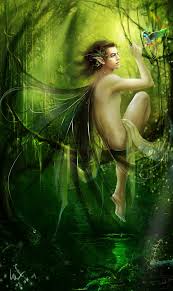
Elf
Elves are generally depicted in one of two ways. The first being small, human-shaped creatures, that employ their magical skills to manufacture many different things from delicious cookies to toys in Santa's workshop. The second is that they are powerful, human-sized beings that are more beautiful and noble than humans. They are genrally long-lived and eternally youthful.
An elf is a mythical creature of Germanic Mythology/Paganism which still survives in northern European folklore. In Norse mythology they were originally a race of minor gods of nature and fertility. Elves are often pictured as youthful-seeming men and women of great beauty living in forests and other natural places, underground or in wells and springs. They have been portrayed to be long-lived or immortal and they have magical powers attributed to them. Following the success of J. R. R. Tolkien's epic workThe Lord of the Rings—wherein a wise, angelic people named Elves play a significant role—they have become staple characters of modern fantasy (see: Elves in fantasy fiction and games).
Elf can be pluralized both as elves and elfs. Something associated with elves or the qualities of elves is described by the adjectives elven, elvish, elfin or elfish. A convention of modern fantasy usage is: the v in elven or elvish refers to human-sized elves (who correspond more closely to the mythology of the Viking Era), whereas the f in elfin or elfish refers to tiny-sized elfs (who correspond more closely to the folklore of the Renaissance and Romantic Eras). |
|
|
|
|
|
|
|
|
|
|
|
jepun

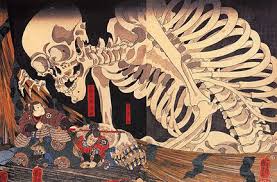
Gashadokuro
A Gashadokuro according to Japanese folklore is a giant skeleton many times taller than a human. It is though to be made of the bones of people who have starved to death. After midnight the ghost roams the streets making a ringing noise that sounds in the ears. If people do not run away when the Gashadokuro approaches it will bite off their heads with its giant teeth. |
|
|
|
|
|
|
|
|
|
|
|
israel
Post Last Edit by polipoplipop at 17-5-2012 15:17
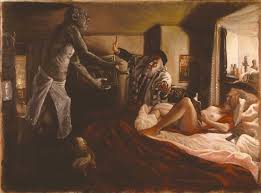
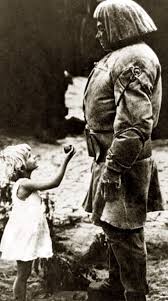
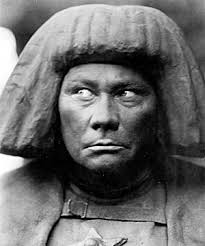
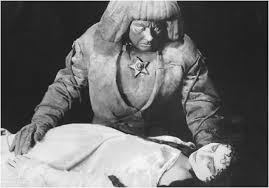
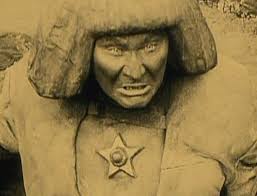
Golem
In Jewish folklore, a golem (גולם, sometimes, as in Yiddish, pronounced goilem) is an animated being created entirely from inanimate matter. In modern Hebrew the word golem literally means "cocoon", but can also mean "fool", "silly", or even "stupid". The name appears to derive from the word gelem (גלם), which means "raw material".
The creatures are said to be controlled by an eye that is placed in the forehead. The controller uses a globe, mirror, or bowl of water to control it. A scroll with runes on it is placed in the creature to bring it to life. After a Golem is destroyed, the scroll being removed, it will return to its master. As the Golem proceeds to its master, with little power left to sustain it, it starts to fall apart. If the distance is short between the master and Golem at the time of the scrolls removal this can sometimes be a problem for the master if they were using the Golem for felony against their people. |
|
|
|
|
|
|
|
|
|
|
|
tanah arab/israel
Post Last Edit by polipoplipop at 17-5-2012 15:23
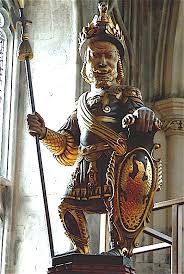


Magog
The first occurrence of "Magog" in the Hebrew Bible is in the Table of Nations in Genesis 10, where Magog is the eponymous ancestor of a people or nation (without any accompanying apocalyptic symbolism, or mention of Gog, although "Magog" may mean "the land of Gog"):2. The sons of Japheth were Gomer, Magog, Madai, Javan, Tubal, Meshech, and Tiras In this occurrence, Magog is clearly the name of a person, although in the anthropology proposed by Genesis, ethnic groups and nations are founded by, and usually named after, their founding ancestors. The names of Gomer, Tubal, Meshech, and Togarmah also occur in Ezekiel. The meaning of the name Gog is uncertain. However, the name "Gog" is listed as a descendant of Reuben at 1 Chronicles 5: 3, 4.
The earliest known reference to "Gog" and "Magog" together is also in the Bible, in the Book of Ezekiel:38:2. Son of man, set thy face against Gog, of the land of Magog, the prince of Rosh, Meshech and Tubal, and prophesy against him, 3. And you shall say; So said the Lord God: Behold, I am against you, Gog, the prince of Rosh, Meshech and Tubal.
Gog is "of the land of Magog" situated in "the remotest parts of the earth." He is the "head chieftain ["great prince" or "chief prince"] of Meshech and Tubal." Although it is clear (in the Hebrew) that here Magog is a "land" (eretz) from verse 2, and that Gog is a "prince" from verse 3, different identifications have been made. The Interlinear Bible (Hebrew - Greek - English) states 2. as: "Son of man, set your face toward Gog, the land of Magog, the prince of Rosh, Meshech, and Tubal; and prophesy concerning him."
The lands mentioned all lay north of Israel, but the conspiracy embraced southern Hamitic members also, namely Put and Ethiopia in Africa. Gog's role, therefore, is as commander of a massive assault force that applies tremendous pressures designed to crush God's people as though they were in a vise. Israel is described as "dwelling in the center of the earth." Ancient Israel was located at a central point as regards the Eurasian and African continents but also was the center of worship of the true God and was counted by him as "the apple of his eye." (De 32:9,10; Zech 2:8) God draws Gog out by restoring and prospering his own name people, who seemingly have no protective "walls" to defend themselves. This incites Gog to manifest his malevolence toward them and attack
Most, if not all (and it is very likely that it is the later than the former) of the references that there are to Gog and Magog are pretty bad. However there are two oddities in this long list of evils of Gog and Magog.
In the Quran:
Gog and Magog appear in Qur'an Surah Al-Kahf (The Cave chapter), 18:83-98, as Yajuj and Majuj (Ya'jūj and Ma'jūj or يأجوج و مأجوج, in Arabic, Yecüc Mecüc in Turkish transliteration). The verses state that Dhul-Qarnayn (the one with two horns) travelled the world in three directions, until he found a tribe threatened by Gog and Magog, who were of an "evil and destructive nature" and "caused great corruption on earth." The people offered tribute in exchange for protection. Dhul-Qarnayn agreed to help them, but refused the tribute; he constructed a great wall that the hostile nations were unable to penetrate. They will be trapped there until doomsday, and their escape will be a sign of the end:
"But when Gog and Magog are let loose and they rush headlong down every height (or advantage). Then will the True Promise draw near " - (Qur'an 21:96-97)
The Quranic account of Dhul-Qarnayn follows very closely the "Gates of Alexander" story from the Alexander romance, a thoroughly embellished compilation of Alexander the Great's wars and adventures
In Britain:
According to the tradition, the giants Gog and Magog are guardians of the City of London, and images of them have been carried in the Lord Mayor's Show since the days of King Henry V.
But here is some back round that makes them not so good guardians:
The Lord Mayor's procession takes place each year on the second Saturday of November.
The Lord Mayor's account of Gog and Magog says that the Roman Emperor Diocletian had thirty-three wicked daughters. He found thirty three husbands for them to curb their wicked ways; they chafed at this, and under the leadership of the eldest sister, Alba, they murdered them. For this crime, they were set adrift at sea; they were washed ashore on a windswept island, which after Alba was called Albion. Here they coupled with demons, and gave birth to a race of giants, among whose descendants were Gog and Magog.
And the Irish:
Works of Irish mythology, including the Lebor Gabála Érenn (the Book of Invasions), expand on the Genesis account of Magog as the son of Japheth and make him the ancestor to the Irish. His three sons were Baath, Jobhath, and Fathochta. Magog is regarded as the father of the Irish race, and the progenitor of the Scythians, as well as of numerous other races across Europe and Central Asia.
Partholón, leader of the first group to colonize Ireland after the Deluge, was a descendant of Magog. The Milesians, or people of the 5th invasion of Ireland, were also descendants of Magog. |
|
|
|
|
|
|
|
|
|
|
|
|
release the kraken!! - Zeus dlm cerita calsh of the titans |
|
|
|
|
|
|
|
|
|
|
|
release the kraken!! - Zeus dlm cerita calsh of the titans
coolie83 Post at 17-5-2012 16:45 
summon the kraken!! - davy jones "pirates of the carribean".. huhu |
|
|
|
|
|
|
|
|
|
|
|
|
ayooo....gambar ade yg 18sx, terkujat den.... |
|
|
|
|
|
|
|
|
|
|
|
aiyew...baru ku tahu semua ni..
thanx TT...nice info |
|
|
|
|
|
|
|
|
|
|
|
Reply 15# polipoplipop
tgk gmbr harpies ni tingat citer jeepers creepers (x tau btl ke x ejaan  ) ) |
|
|
|
|
|
|
|
|
|
| |
|